Imagine entering a vast, aesthetically pleasing bookstore. You immediately become excited about all the books you can read but quickly understand that an abundance of choices can, let's be honest, be overwhelming.
If only the library were well-organized and categorized books into sections and shelves to ensure you didn’t feel lost like Alice in Wonderland. Smooth navigation would take your experience from good to terrific.
Websites are not much different. Search engine algorithms may struggle to understand the context and relevance of the content on a site. Striking visuals won’t compensate for inefficient crawling and indexing.
Don’t worry. We’ll ensure bots don’t get confused or lost when visiting your website. How? This article will dissect topic clusters and how you can benefit from them.
What are Topic Clusters?
Topic clusters are a strategic SEO approach that organizes website content into hierarchical groups centered around core topics. This method, also known as content siloing, interlinks subtopic pages with the pillar page, creating a cohesive structure.
Pillar Pages and Topic Clusters
Typically, one cluster corresponds to one pillar page, but there can be cases where multiple cluster pages are associated with a single central page. A pillar page acts like an entrance to the bookstore, exposing you to a broad view of all books on a similar topic. Meanwhile, different cluster pages unlock associated subthemes.
The connection between pillar pages and topic clusters lies in their interlinking structure. Pillar pages are the central hub or main anchor point, while topic clusters revolve around and link back to the pillar page.
And the result? – A cohesive and interconnected content ecosystem, where each piece of content reinforces the authority and relevance of the overarching topic. Ultimately, that ensures users will have a much better time on the website, while search engines will have no trouble understanding topical relevance.
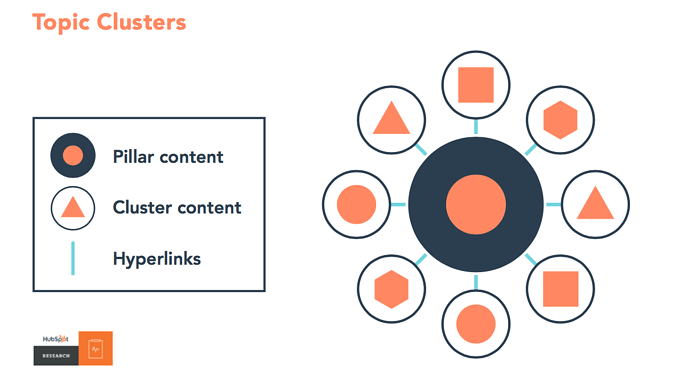
Why are SEO Topic Clusters Important?
Keywords are no longer the main trick to appeal to Google when pursuing high rankings. Google has been parsing subtopics, synonyms, and industry-related FAQs for some time now. Thanks to this, topic clusters have become the next big thing in SEO content strategy. They signal to Google that your website is a source of expertise users seek, providing in-depth data about relevant topics in the industry.
However, building SEO topic clusters isn’t as simple as it may sound. It requires time, effort, and research. This is part of the reason why this approach signals topical authority, nudging Google to reward your website with better rankings and organic traffic. Topic clusters also help bots understand your website’s hierarchy, as they mirror your site’s architecture in a way.
Topic Clusters are a SEO Practice, Not Google’s Requirement
Keep in mind that Google doesn’t specifically highlight topic clusters as beneficial. Instead, their benefits align with Google’s Webmaster Guidelines, which emphasize the importance of a clear conceptual page hierarchy in website design.
This means SEO professionals created the topic cluster framework to adapt to changes in search engine algorithms and user behavior. Topic clusters increase SEO effectiveness because they:
- Organize related content into cohesive clusters to improve discoverability for users and search engines.
- Contribute to establishing topical relevance and authority by thoroughly addressing a specific subject.
- Assist in naturally generating valuable internal links.
- Allow a coherent variety of long-tail keywords, expanding their reach and relevance.
Time to further explore this method by clarifying how it may look in practice.
Topic Clusters Examples
The following examples of topic clusters will make this approach less abstract and likely give you an idea of how to develop your own.
Lonely Planet: Namibia Content Cluster
Any traveler considering a specific destination and wanting to learn everything about it would appreciate having all the info in one place. This travel and tourism website offers comprehensive travel guides and destination information.
Its topic clusters categorize content based on destinations, and for this example, we chose Namibia. The pillar page is easy to navigate and provides an overview of various clusters, such as Attractions.
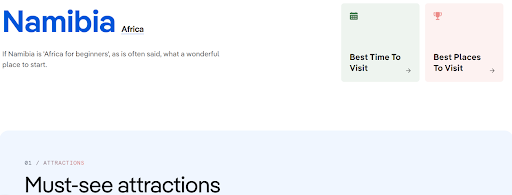
Within each cluster content page, Lonely Planet includes contextual links to related articles, guides, and resources. For instance, the page about the natural attraction Sossusvlei interlinks to other striking destinations.
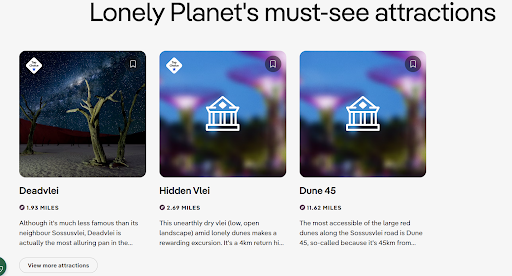
Healthline: Fibromyalgia Content Cluster
If looking for a well-organized website with various topic clusters, head to Healthline. This health and wellness site covers anything from nutrition to skincare, but we chose their comprehensive article on fibromyalgia, a condition causing pain all over the body.
Titled Everything You Need to Know About Fibromyalgia, this text serves as a pillar page for this illness. It includes subtopics, such as Symptoms, Treatment, Causes, Tender Points, and Risk Factors.
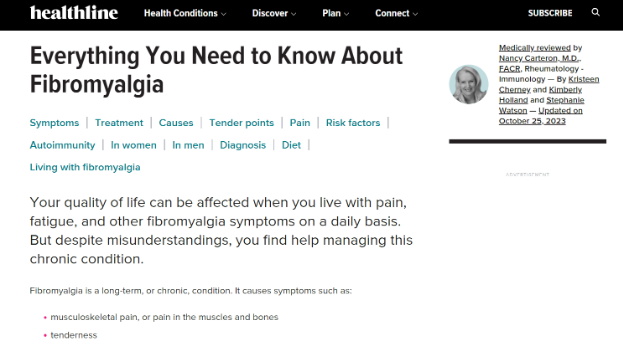
This article demonstrates expertise and authority by providing an in-depth overview of every issue that may concern a person struggling with fibromyalgia. It also links to cluster pages with additional info, such as medication.
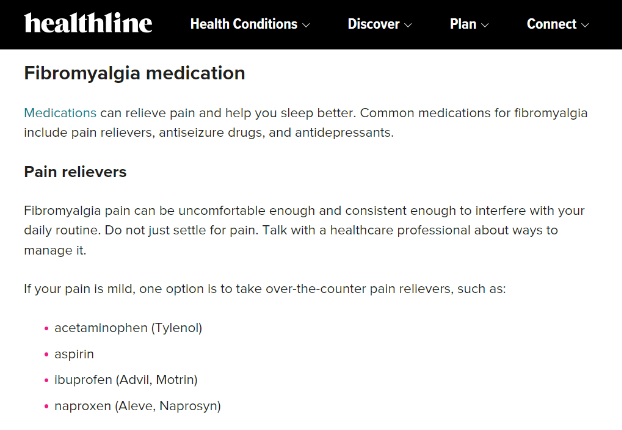
Moreover, you can find the linked cluster pages dedicated to the Fibromyalgia Diet.

Investopedia: Cryptocurrency Content Cluster
Investopedia’s pillar page on cryptocurrency acts as an overarching guide with multiple cluster pages dedicated to different topics. For instance, Cryptocurrency Essentials probes the subject through various articles, including How to Invest in Cryptocurrency and How to Find New Cryptocurrencies for Investment.

These texts delve deeper into specific aspects of cryptocurrency, interlinking to relevant pages, such as What to Know About Investing in Crypto Exchanges.

What do all these examples have in common that makes them effective?
Structure of an Effective Pillar Page and Topic Clusters
Pillar Page:
- Clear Title: The overarching topic or theme of the pillar page is well-defined.
- Comprehensive Overview: The central hub provides a broad overview of the main topic, covering key concepts, definitions, and key information.
- Subtopic Sections: The pillar page divides into different sections corresponding to specific subtopics or themes within the main topic.
- Internal Links: Internal links lead to related cluster pages and other relevant content on the website.
Topic Clusters:
- Specific Theme: Each cluster page focuses on a specific subtopic related to the pillar page.
- Detailed Content: Content provides in-depth information, insights, and practical advice on the cluster topic.
- Internal Links: The cluster page is interlinked with the pillar page and other relevant cluster pages, resulting in a cohesive content structure.
How to Create Topic Clusters?
Ready to get started and develop topic clusters on your website? Here are the steps to follow.
1. Decide Core Pillar Topics
The content cluster should revolve around relevant content that demonstrates your expertise. Consider the following questions when brainstorming:
- What content resonates with your audience and addresses their needs?
- What are your business goals and values?
- What are the current industry trends and popular keywords?
- What existing content do you have?
- Which topics have previously driven organic traffic and user engagement?
- What is your field of expertise and authority?
- Which topics are your competitors covering?
Once you’ve answered these questions, remember that the goal is to meet the informational search intent and choose a topic broad enough to create subtopics. An overly narrow theme may limit your scope of relevant keywords for SEO topic clusters.
2. Discover Keywords with a High Traffic Potential
Although we’ve touched on considering relevant keywords, this one deserves more attention. Your objective is to create SEO-friendly content, which you can achieve by using platforms such as Google Keyword Planner, SEMrush, and Ahrefs to research.
Identify high-volume keywords related to industry topics and audience interests, targeting terms with a promising traffic potential. Consider long-tail keywords for specific niche topics and target audience queries to address user search intent and capture relevant search traffic.
The next step is to assess the keyword competitiveness to refine the keyword list and focus on the most impactful terms. You can also explore related keywords, synonyms, and variations to expand the keyword pool and target a broader range of search queries.
3. Target Keywords on Cluster Pages
When creating cluster pages, ensure the content matches the target keywords identified in keyword research. For instance, if the target keyword is “responsive web design tips,” add a cluster page offering practical advice on designing responsive websites.
Optimize cluster page content, headings, and metadata with target keywords for improved SEO visibility. You can, for example, include the target keyword in the page title and headings.
Descriptive titles and headings are a good way to include keywords that capture user attention and signal relevance (e.g., 10 Effective Email Marketing Strategies). Another valuable strategy is internal linking between cluster pages with descriptive anchor text that boosts content coherence and navigation.
4. Create Engaging, Quality Content
Consider starting with a pillar page, providing an overview of the main topic and links to cluster pages. Structure headings logically and remember to use primary and secondary keywords while ensuring a natural flow.
Although SEO is valuable, you should prioritize user value, which translates to clear, concise, and informative content. Internal linking will help you connect cluster pages and improve navigation and SEO.
To illustrate, let’s consider a topic cluster focused on Healthy Meal Planning. A potential SEO-friendly title could be Healthy Meal Planning Guide: Essential Tips and Recipes.
Subtopics within the cluster may include:
- Nutrient-Rich Ingredients
- Meal Prep Techniques
- Healthy Recipe Ideas
For instance, the pillar page might feature sections such as:
- Nutrient-Rich Ingredients: Building Blocks for Healthy Meals
- Meal Prep Techniques: Streamlining Your Weekly Cooking Routine
- Healthy Recipe Ideas: Delicious and Nutritious Meals for Every Occasion
Each cluster page would dive deeper into its designated subtopic, providing detailed info, practical tips, and inspiring recipes that resonate with the audience.
5. Gauge the Performance of Your SEO Clusters
The only way to know whether your topic clusters are working is to monitor their performance and tweak them when necessary, as the insights you gain allow you to expand the best topic clusters and address the ones not reaching your audience. You can use various metrics and tools to gauge effectiveness.
- Organic Traffic: Use analytics tools like Google Analytics to compare traffic trends over time and assess the impact of cluster optimization efforts.
- Keyword Rankings: Track keyword rankings for target keywords associated with each cluster page with SEO tools like SEMrush or Ahrefs.
- Engagement Metrics: Check your user engagement metrics for cluster pages, such as bounce rate, average session duration, and pages per session.
- Conversion Rates: Pay attention to conversion rates for cluster pages (e.g., form submissions, downloads, or purchases) to understand how effectively content converts visitors into leads.
- Backlink Profile: The backlink profile of cluster pages is among the best approaches to determine their authority, credibility, and the acquisition of new backlinks over time.
Use SEO Topic Clusters to Make Your Content Stand Out
Creating quality content is always a great strategy to engage your existing audience and attract new ones. However, topic clusters represent a higher level of demonstrating your knowledge and expertise. Achieving this goal can be ambitious, especially if you have limited time, are unsure where to start, or struggle to choose the best keywords. In such instances, it’s best to reach out to professionals who offer SEO services and can help increase your traffic.
Interested in more resources that can streamline your SEO strategy?





